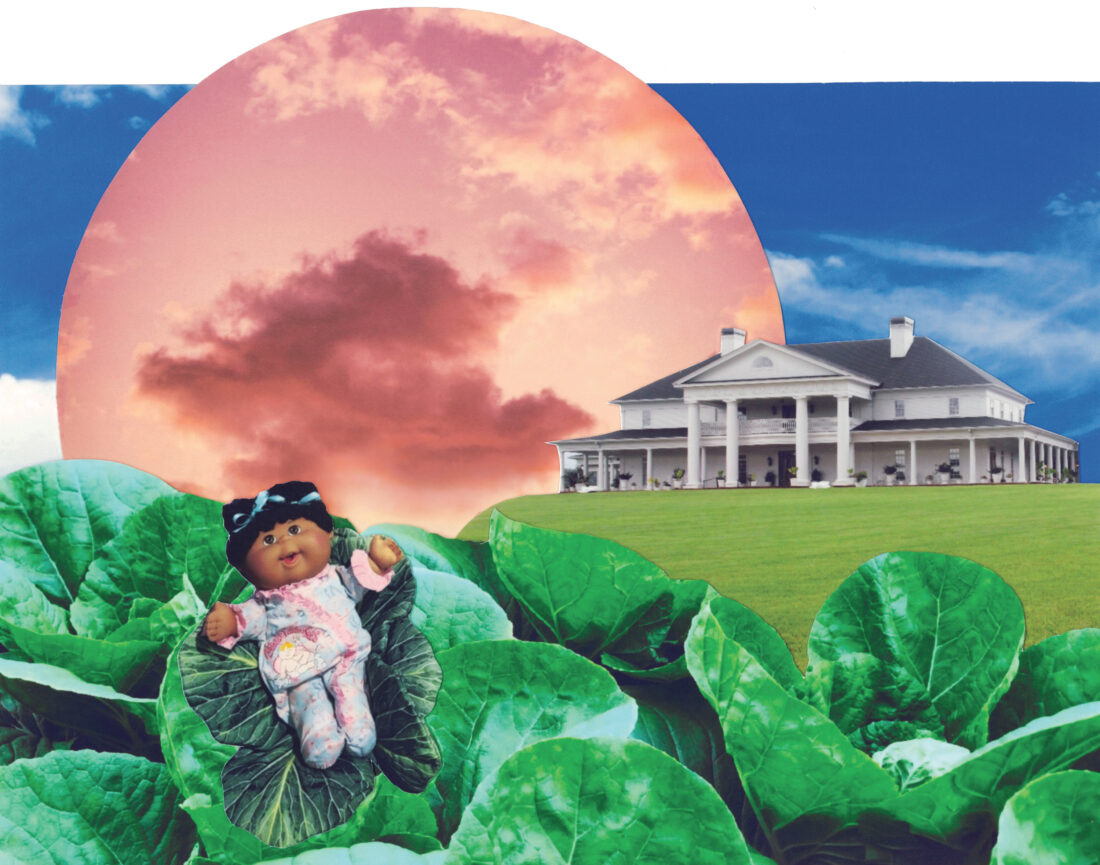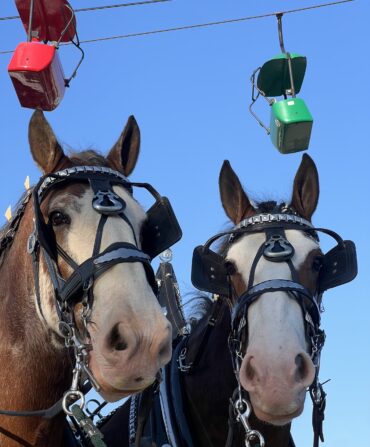I found myself at BabyLand General Hospital, the home of the Cabbage Patch Kids, on a lark. Late last year, I attended a writing residency at Hambidge Center for the Creative Arts and Sciences near Dillard, Georgia. Winding my way through the North Georgia mountains, I saw one billboard after another advertising the tourist attraction, in Cleveland, with an image of one of the dolls, a round-faced, ruddy-cheeked girl with pigtails. Once one of the most popular toys of my 1980s childhood, Cabbage Patch Kids can still be found on store shelves, though they seem of a bygone time, a relic of the era before electronic doodads like Nano Pets gave way to the gaming boom. I hadn’t thought about the dolls in decades, but the ads ignited my nostalgia.

At Hambidge I bonded with Jane, a Los Angeles ceramist, and Zoe, a violinist specializing in klezmer music, and as our time together drew to a close, we decided to abandon our studios for an artists’ day out. We would hike at Tallulah Gorge, where portions of Deliverance were filmed. Thanks to those billboards, we planned to wander the gardens and grounds of BabyLand. Then we would jaunt to the German-inspired town of Helen.
Though I had no clue what awaited within the looming seventy-thousand-square-foot plantation house where BabyLand has operated since 2009, I was curious. Before we even parked, we stopped to take pictures by the welcome sign, which featured a ten-foot-high cartoon stork holding a Cabbage Patch Kid in its beak, a set of white sculptures of cherubic faces popping out of cabbages at its feet. Inside, we giggled through the self-guided tour, pretending to be too cool for childish things while internally marveling at these bits of plastic and fabric, so powerful they once caused consumers to lose their minds. In the early 1980s, after the Georgia artist Xavier Roberts partnered with a toy maker to rebrand his Little People dolls for the general public, riots broke out in stores. “With thousands of Cabbage Patch Kids ready for adoption, you are sure to find your perfect match,” read the BabyLand literature. And that had been part of the appeal, particularly for people of color. Unlike Barbie, who came in only a few flesh tones back then, Cabbage Patch Kids featured a variety of hues and hair types.
My family had an in with the dolls—my father managed a Hills department store, so he knew when a shipment would arrive. One my parents thought might be perfect for me popped up in Huntsville, Alabama, where we were living, when I was about six months old. I don’t remember her name, which came printed on the adoption papers that accompany each Kid. But her textured yarn hair was the closest toy companies came at the time to re-creating my own head of curls, and she became my childhood companion.
When I was around nine, allergies started to plague me and my brother, our stuffed animals the alleged culprits. One day, they were gone. My Cabbage Patch Kid was the only bit of softness and solace they allowed me to keep, her plastic face sparing her from the trash bag. My father had lost his job; things were tight. We never got replacements. I kept her until my parents considered me too old for such things—ten or so—and then she disappeared.
I saw versions of her face and auburn eyes tucked into bassinets all around BabyLand. If I wanted to, I could purchase one. As a writer constantly on the road, though, I told myself that it wouldn’t make sense. A doll would only collect dust—otherwise, how would I look taking it with me from city to city?
Just as I was contemplating all of this, my world became even more nonsensical. We were departing the largest room in BabyLand, where Mother Cabbage rests, flanked by hundreds of baby heads sprouting from cabbages, all shaded by the Magic Crystal Tree, when the lights on the tree started to flash. An announcement came over the faux hospital’s intercom: “Cabbage dilation is now nine leaves apart!”
Mother Cabbage was giving birth. Awestruck, we sat down on a bench in front of the patch. “Cabbage dilation is now ten leaves apart. Nurse Tina to delivery, stat!…All staff, code green!” A woman with blond hair dressed in a nurse’s uniform emerged and walked us through the birth process. I had flashbacks to my evangelical upbringing, one steeped in a purity culture that emphasized strict gender roles, abstinence, modesty, and metaphor—the birds and the bees, or in this case, Mother Cabbage Patch and the pollinating Bunnybees. There are so many things my foremothers never discussed, ones my mother and I still don’t speak about. That uneasiness only heightened when Nurse Tina invited any men who felt “a little queasy” to escape the birthing room for the “father’s waiting room,” leaving the women to witness.
She then instructed us to yell, “Push!” on her count, and over and over we did, until she pulled out forceps the size of my torso and plunged them into the verdant hole in front of her. A Black baby, the color of mahogany, emerged.
Am I about to buy a Cabbage Patch Kid?
My desire for the doll skyrocketed when Tina tasked us with naming it. We decided on Hambidge Foxfire, after the residency and the name of my cabin there. The nurse seemed confused but shrugged. The performance over, she took the newly released doll into the nursery and hooked it up to a heart monitor. Her dedication to the bit was awe-inspiring. Caught up in the moment in a way I still can’t explain, I asked how much the doll cost. If I wanted to take the hand-stitched Hambidge home with me, Tina replied, the adoption fee would be $260, plus tax.
Excuse me? Apparently even in fabric form babies are expensive. As I left Hambidge, a Black baby surrounded by the all-white faces of the nurses, in a visitor center styled after a plantation, I felt like a monster. Then I felt stupid for having feelings for a doll. I suppressed those emotions and continued the tour, purchasing a green tie-dyed tee on my way out.
Heaven help me, BabyLand had both charmed and unsettled me. The whole visit had been a joke, until it wasn’t. I found myself thinking of my own long-gone Cabbage Patch Kid, about how the almost fortyyear-old doll might feel—soft and pliable? Would her baby powder scent remain? Would her face be fragile to my touch?
Hambidge’s last name, Foxfire, refers to the name of the bioluminescence emitted by a forest fungus. The phenomenon, also called fairy fire, happens when two chemicals, luciferin and luciferase or photoprotein, come in contact with each other. As we left BabyLand, I wondered if I could blame my disgruntled feelings on chemistry too.
Rarely am I confronted with such raw longing, a want so deep I can’t shake it. My time at BabyLand unearthed a once long-held ambition I have done my best to stash away: to be a mother. The path I’ve chosen in the arts means I have less time (and money) to make that yearning a reality.
People who decide to adopt a Cabbage Patch Kid—BabyLand seems to prefer to avoid the word purchase—must take the Oath of Adoption: I promise to love my Cabbage Patch Kid with all my heart. I promise to be a good and kind parent. I will always remember how special my Cabbage Patch Kid is to me. At this point in my life, I could not promise all of that to a doll, let alone a real child.
Thinking back to my childhood, I realized my own parents didn’t always have the ability to keep those promises, either. The two did the best they could with what they had, and it was enough to get by, but perhaps not enough to thrive. That experience gave me the power of perspective, and with that frame of reference, a choice.
Since then, things haven’t necessarily gotten easier for mothers. I’ve watched my friends have and raise children, using adjectives like weird, awkward, ridiculous, gross, funny, uncomfortable, fun, strange, and awesome to describe the experience. But I’ve also discussed with them the challenges of parenting amid economic insecurity and political uncertainty. How the government is limiting women’s ability to decide for themselves whether they want the role. How the South has the highest maternal mortality, infant mortality, and preterm birth rates in the country, particularly for Black mothers and babies.
My BabyLand visit prompted all of this to coalesce—the dolls, poverty, motherhood, trauma, my body. And I remembered that along with any ambivalence comes a freedom. To refuse a raison d’être so long pushed by society. To imagine more than one kind of future for myself.








